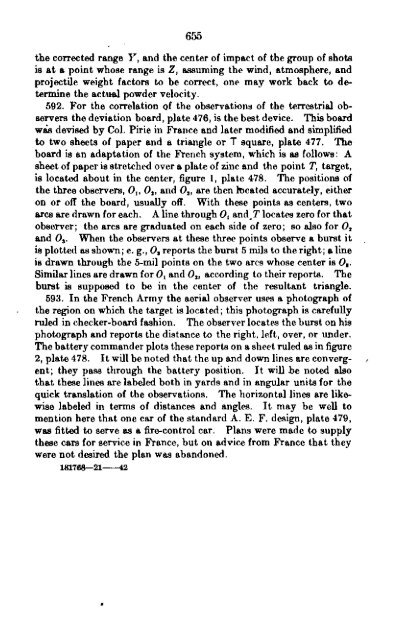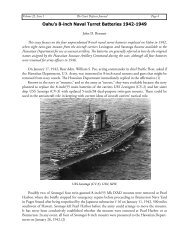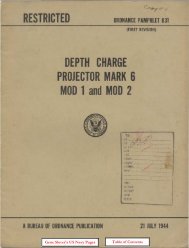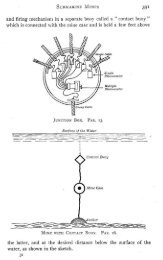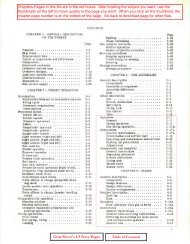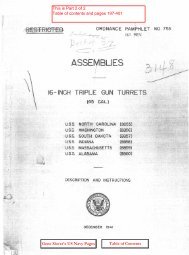...Railway artillery - Personal Page of GENE SLOVER
...Railway artillery - Personal Page of GENE SLOVER
...Railway artillery - Personal Page of GENE SLOVER
You also want an ePaper? Increase the reach of your titles
YUMPU automatically turns print PDFs into web optimized ePapers that Google loves.
655<br />
the corrected range Y, and the center <strong>of</strong> impact <strong>of</strong> the group <strong>of</strong> shots<br />
is at a point whose range is Z, assuming the wind, atmosphere, and<br />
projectile weight factors to be correct, onl' may work back to determine<br />
the actual powder velocity.<br />
592. For the correlation Qf the observations <strong>of</strong> the terrestrial observers<br />
the deviation board, plate 476, is the best device. This board<br />
was devised by Col. Pirie in France and later modified and simplified<br />
to two sheets <strong>of</strong> paper and a triangle or T square, plate 477. The<br />
board is an adaptation <strong>of</strong> the French system, which is as follows: A<br />
sheet <strong>of</strong> paper is stretched over a plate <strong>of</strong> zinc and the point T, target,<br />
is located about in the center, figure 1, plate 478. The positions <strong>of</strong><br />
the three observers, 0 1, 0" and 0" are then k>cated accurately, either<br />
on or <strong>of</strong>f the board, usually <strong>of</strong>f. With these points as centers, two.<br />
arcs are drawn for each. A line through 0 1 and,T locates zero for that<br />
observer; the arcs are graduated on each side <strong>of</strong> zero; so also for 0,<br />
and 0.. When the observers at these three points observe a burst it<br />
is plotted as shown; e. g., 0, reports the burst 5 mils to the right; a line<br />
is drawn through the 5-mil points on the two arcs whose center is 0,.<br />
Similar lines are drawn for 0 1 and 0" according to their reports. The<br />
burst is supposed to be in the center <strong>of</strong> the resultant triangle.<br />
593. In the French Army the aerial observer USl'S a photograph <strong>of</strong><br />
the region on which the target is located; this photograph is carefully<br />
ruled in checker-board faShion. The observer locates the burst on his<br />
photograph and reports the distance to the right, lp,ft, over, or under.<br />
The battery commander plots these reports on a sheet ruled as in figure<br />
2, plate 478. It will be noted that the up and down lines are convergent;<br />
they pass through the battery position. It will he noted also<br />
that these lines are labeled both in yards and in angular units for the<br />
quick translation <strong>of</strong> the observations. The horizontal lines are likewise<br />
labeled in terms <strong>of</strong> distances and angles. It may be well to<br />
mention here that one car <strong>of</strong> the standard A. E. F. design, plate 479,<br />
was fitted to serve as a fire-control car. Plans were made to supply<br />
these cars for service in France, but on advice from France that they<br />
were not desired the plan was abandoned.<br />
181768-21--42<br />
•<br />
Digitized by Coogle


